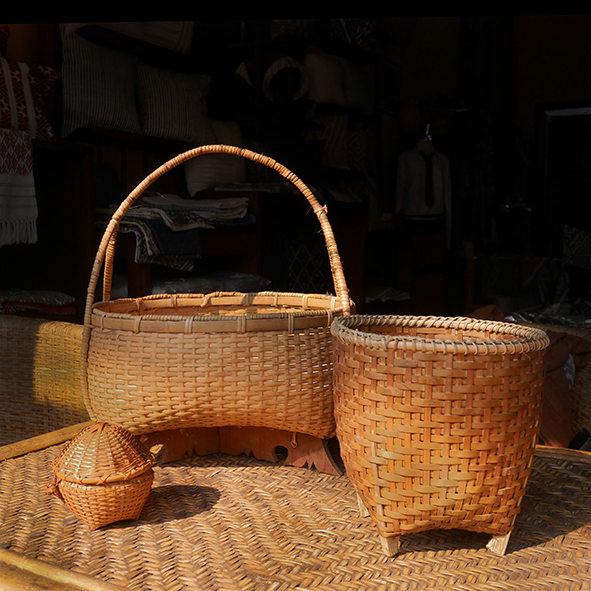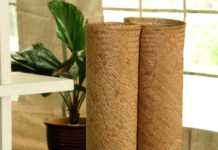Members of the diverse population of Laos continue to produce a variety of baskets (ka-ta). Men of different ethnic backgrounds interlace bamboo (phai) and, sometimes, rattan (vai) into stools (tang), storage containers, and tables (toh), for example. Women from the Hmong ethnic group are an exception, weaving carrying baskets. Some ethnic groups, such as the Khmu and Lahu, excel at this craft and sell examples to other ethnic groups for fabric and other goods. Khmu artisans are nationally renowned for their baskets composed of bamboo and rattan.
 Women utilise baskets lacking covers to carry firewood or kindle, rice, vegetables, and other items from the fields and the forest to their domiciles. The shapes of the baskets vary per ethnic group. Men keep their tools, such as machetes, in long containers of plaited bamboo. To make morning alms, Tai Lue Lay people carry food offerings in baskets with legs (Tai Lue: saa) to Buddhist temples.
Women utilise baskets lacking covers to carry firewood or kindle, rice, vegetables, and other items from the fields and the forest to their domiciles. The shapes of the baskets vary per ethnic group. Men keep their tools, such as machetes, in long containers of plaited bamboo. To make morning alms, Tai Lue Lay people carry food offerings in baskets with legs (Tai Lue: saa) to Buddhist temples.
Different types of lidded baskets exist. Strips of bamboo are interlaced (saan or jak saan) to create round containers (ka-dip) to hold steamed sticky rice. The size varies, depending if the amount of rice is for a single serving, for a family, or a large party. Oval-shaped versions store jewellery and dried tobacco. Large, lidded baskets function as a closet or pantry for clothing and rice, respectively. The Tai Dam version of this mobile closet is decorated with patterns resembling textile motifs.
To produce traps, men also lightly pack the bamboo to create an open-weave. The traps capture birds, eel, fish, frogs, and other creatures. Ranging in size, freshwater shrimp traps (sai) are elongated with one pointed end. Open-weave is also applied to make travelling cases for domestic fowl.
Basket weaving remains vibrant in Laos since families and businesses use the above-mentioned items on a regular basis. Both steam sticky rice in v-shaped baskets (huak). Local markets offer a variety produced in the vicinity. Artisans sell their products in their villages and alongside roads. Individual artisans are not known by name, but villages are recognised as the source of specific types of baskets.





